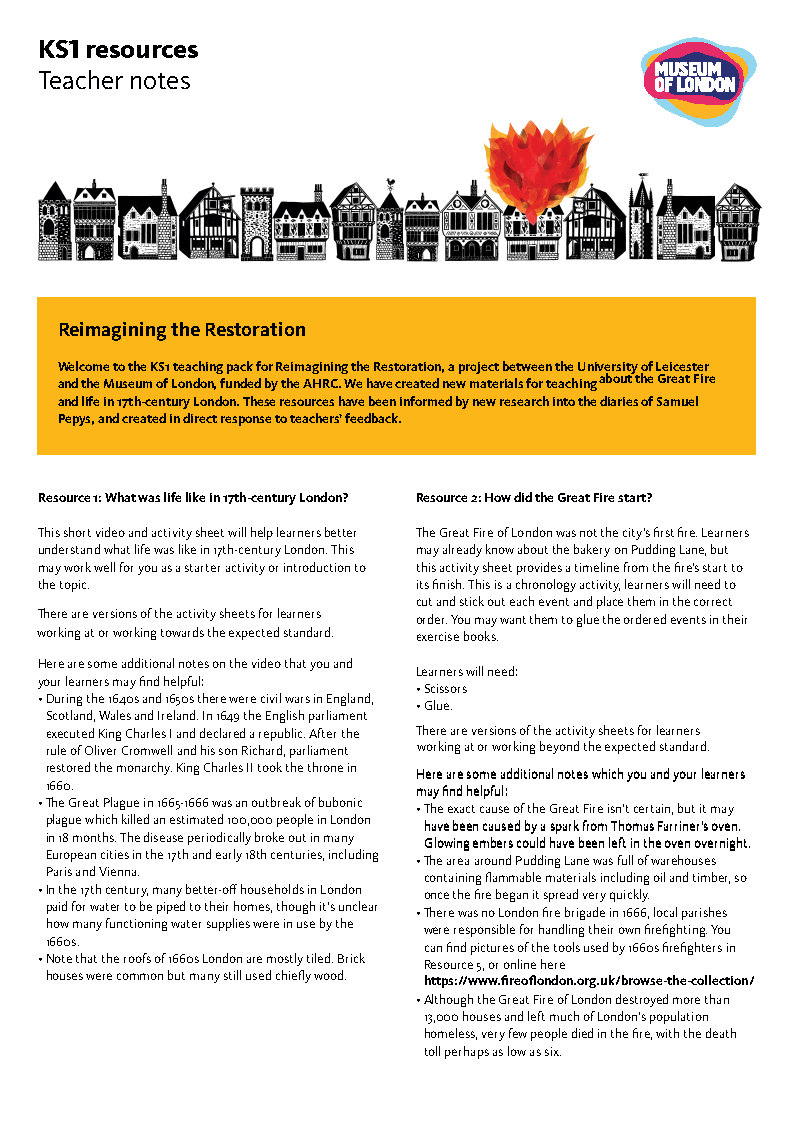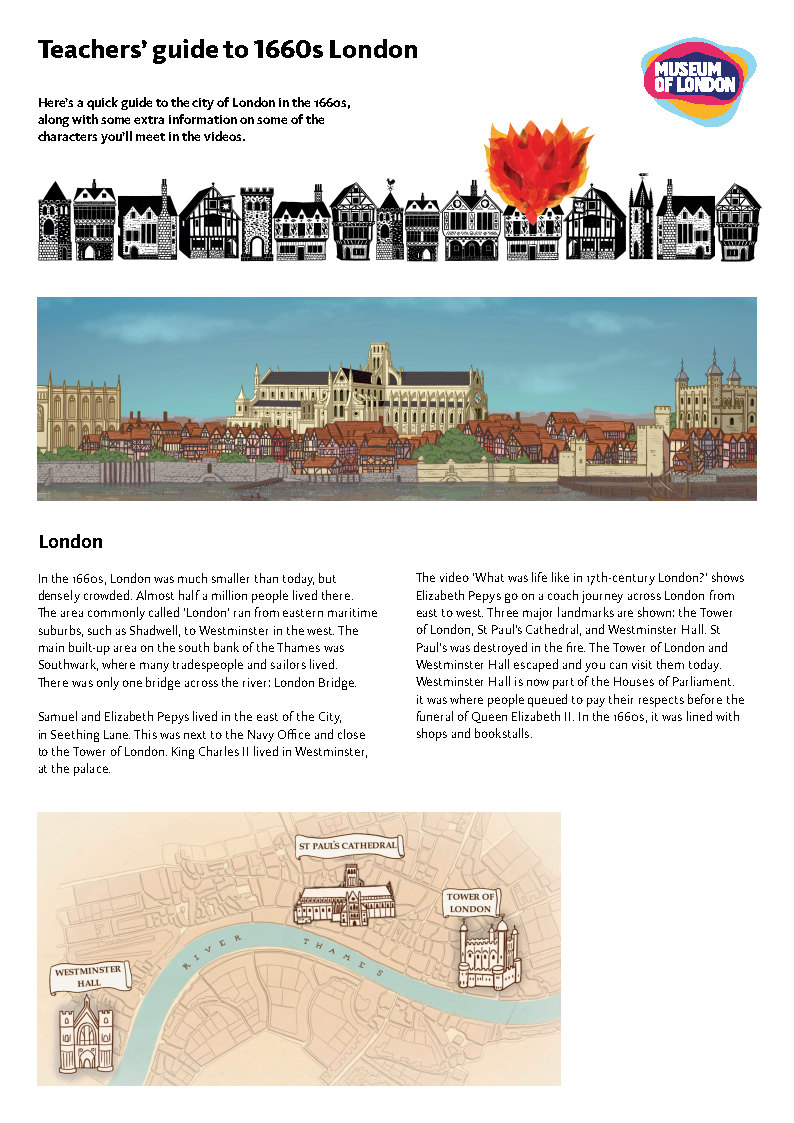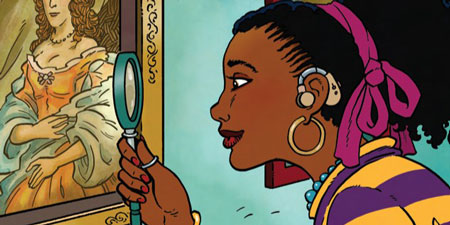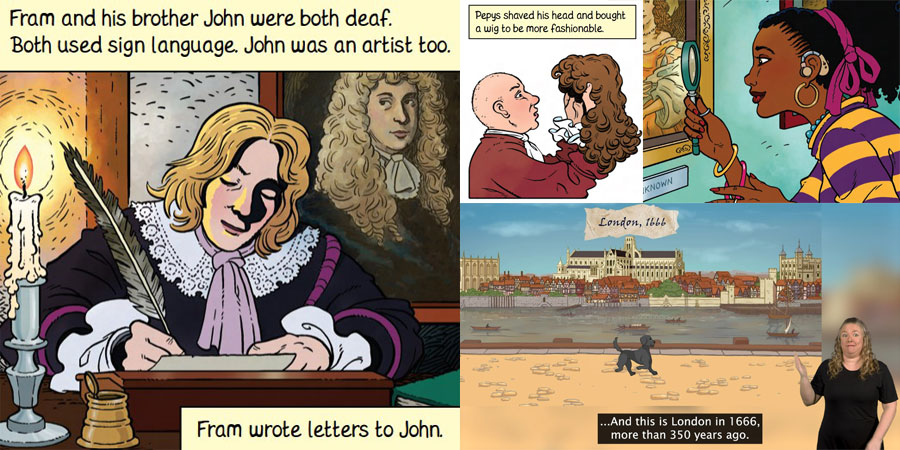The Great Fire of London teaching resources
Get your class to explore the Great Fire of London with our animated videos and a variety of activities, created for KS1 teachers. Some of the activity sheets are available in different versions, differentiated for students working towards, at, or beyond the expected level.
Teachers' notes for these resources
- The KS1 teachers' notes provide additional facts and context for each of the resources below, and some instructions for using them in your classroom.
- The teachers' guide to 1660s London explains who the characters in the three videos below are, with details about their lives and their connections to Pepys's diary.
1. What was life like in 17th-century London?
- This video and activity sheet are the perfect introduction to life at the time of the Great Fire of London.
Please note, this video contains a street scene from the plague at 00:23.
This is London. And this is London in 1666, more than 350 years ago.
London was an exciting and sometimes dangerous place to live in the 17th century.
After years of civil wars and revolution, King Charles II had been crowned king. In 1665, a frightening illness, the plague, had killed many people and others had left the city until it was safe to come back.
In 1666, life was starting to get back to normal in London. People had returned.
In 17th-century England, some children went to school, but many children worked to earn their living. They carried messages, worked as servants in houses, or learned trades.
There were many wooden houses in London. The streets were crowded, narrow and very dirty.
Water came from the pumps in the streets. There were no flushing toilets in houses.
To get around London, people walked, took a boat on the river or, if they were rich, travelled by coach.
Just like today, London was the biggest city in England: almost half a million people lived in the city in 1666.
People had come from all across Britain and from other countries to live and work there.
Some people in London were shopkeepers, some were servants, politicians, or bakers, as well as lots of other jobs.
All of these people were living in London when, in September 1666, a great fire destroyed much of the city.
Most people couldn't write down records of their lives, but some people were able to write about what they saw and heard.
Using eyewitness accounts, artefacts, and pictures from the time, we can find out about how the fire started, how it was put out, and how it changed London forever.
- Watch a BSL-interpreted version of this video
- The activity accompanying the video is available in two versions:
- What was life like in 17th-century London? Activity sheet (incl. answers on page 3)
- What was life like in 17th-century London? Activity sheet - with a little help
2. How did the Great Fire of London start?
- This timeline activity teaches learners the story of the Great Fire from start to finish, while building their chronology skills. There are two difficulty levels:
- How did the Great Fire of London start? Cut and paste timeline activity
- How did the Great Fire of London start? Cut and paste timeline activity - extra challenging
3. How do we know what happened?
- This activity sheet introduces the concept of historical evidence, explaining primary and secondary sources. There are two difficulty levels:
- How do we know what happened? Historical sources activity
- How do we know what happened? Historical sources activity - with a little help
4. Who was Samuel Pepys?
- This video and activity sheet introduce the life and work of the man behind the famous diary.
Photograph of the Pepys Library by Andrew Dunn (CC BY-SA 2.0)
This is Samuel Pepys. He is best known for keeping a diary about his life, which he wrote in the 1660s. But who was Samuel Pepys?
He was born in London in 1633. Pepys's father was a tailor and his mother ran the busy household. Pepys worked hard at school, which meant he could go to university in Cambridge.
Pepys moved back to London and started keeping his diary in 1660, writing about what he did every day. He also started working as an administrator for the navy. Pepys’s job was to see that the navy ships and sailors had everything they needed. His job meant he met lots of important people, including King Charles II.
In his diary, Pepys wrote about all the different people that he talked to and met in London. He included his secret thoughts and his bad behaviour. This all makes his diary great for understanding what life was like in 17th-century London.
Pepys’s diary tells us about major historical events like the coronation of Charles II, the Great Plague, and the Great Fire of London. Pepys was worried that his house might burn down too. He even buried his valuable cheese and wine, and some other things in the ground to protect them from the fire. Luckily, Pepys's office and house survived the Great Fire and the diary did too.
Once he stopped writing his diary in 1669, he still did lots of interesting things. He was an MP, did more important navy work, and was even arrested for treason! Because he wanted his diary to be secret, Pepys wrote it in shorthand to make it difficult for people to read. Shorthand uses symbols instead of letters, so you have to know what the symbols mean to understand it. Many years later, when Pepys was an old man, he decided that he did want people to be able to read his diary after he died.
He arranged for his diary and his other books to be kept safely by his old college in Cambridge. The diary was there for 100 years before people realised how to read the symbols and understood that Pepys had kept a secret diary. The diary is still there today!
- Watch a BSL-interpreted version of this video
- The activity accompanying the video is available in two versions:
- Who was Samuel Pepys? True or false activity (including answers on page 2)
- Who was Samuel Pepys? Multiple choice activity
4.a. How did Pepys write his diary?
- Learn more about how Pepys kept his diary secret and try reading the words he wrote.
- Teachers' guide to Samuel Pepys's diary containing images of the diary
- Pepys shorthand activity sheet
5. How did people fight the Great Fire of London?
- Using objects from the museum’s collection, this group activity challenges learners to think about 17th-century firefighting tools.
- Firefighting objects activity sheet
6. How did they rebuild London?
- This video explains how London has changed since the Great Fire.
In September 1666, London burned. After five days, the fire was mostly out. More than 13,000 houses burned down in the Great Fire of London. The old St Paul's Cathedral was just one of the famous London landmarks that was destroyed. Churches, shops, and schools were gone too.
Rebuilding the city would be a huge task and the new London needed to fix the problems of the old city to make sure another fire like this couldn't happen.
Houses in London were often built of wood and jutted out very close to each other, which meant they burned very easily, so the new buildings would have to be made of brick and stone. Strict rules were made about the size and shape of the new houses. Where it was possible, narrow streets were sometimes made wider.
In the 17th century, London didn't have a big fire brigade like today. The city was divided into areas called parishes. Each parish kept buckets, hooks and axes, and local people were supposed to work together to stop the fires. After the Great Fire, new rules were made to make sure every parish had more equipment.
One of the men chosen to take charge of rebuilding London was Christopher Wren. He was an architect who designed buildings. He planned many of London's new churches, including a new St Paul's Cathedral.
While there were lots of exciting ideas for transforming London, most of the grand plans would have cost too much money. There wasn't time to change where the streets were or how the city worked. People needed their homes, businesses, and their schools to be rebuilt quickly. So they started rebuilding where they had lived before. Today, many of the streets in the City of London have the same names and are in the same places as before the fire.
London looked very different after the fire and since then it has changed, and keeps changing – and growing! Today, London is over 100 times bigger than it was before the fire and 9 million people live there.
- Watch a BSL-interpreted version of this video
- The activity accompanying this video helps learners build connections between causes, problems, and solutions.
- How did they rebuild London? Card sorting activity
These resources were produced by the Reimagining the Restoration project, a partnership project between the Museum of London and the University of Leicester. Funded by the Arts and Humanities Research Council (grant ref. AH/W003651/1).
We'd love to know what you think of these resources. Please get in touch with [email protected] and [email protected]











